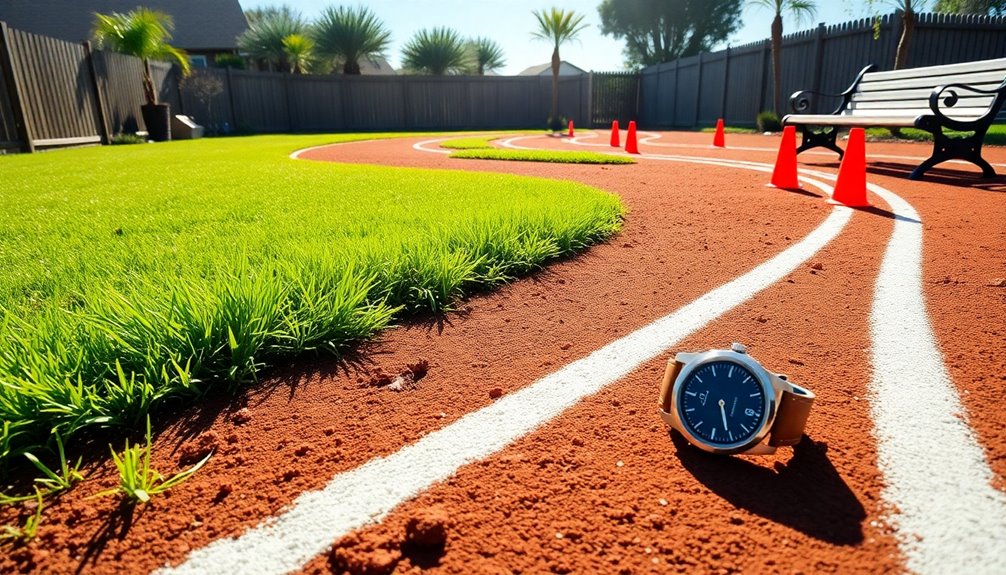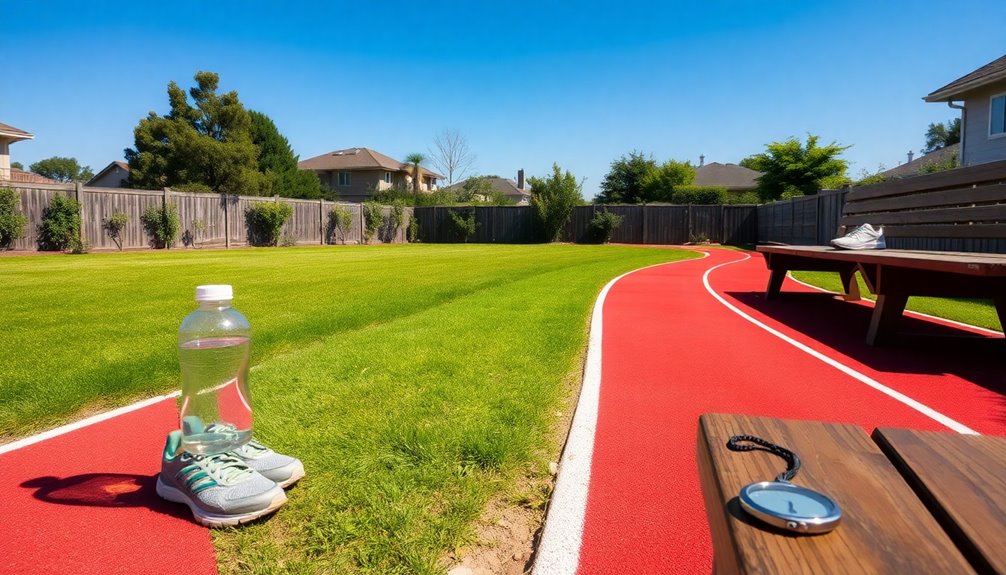To create a home track for consistent training, start by selecting an accessible location, like a quiet park or flat backyard. Design a loop between 200-400 meters with a safe surface, incorporating markers for progress tracking. Mix up your workouts with intervals, hill sprints, and strength exercises to keep things fresh. Set measurable goals and use a habit tracker to stay motivated. There's more to explore about optimizing your training experience for better results.
Key Takeaways
- Select a flat, open space of at least 100 meters for effective drills and easy accessibility from home.
- Design a loop between 200-400 meters on safe surfaces to enhance training variety and minimize injury risks.
- Incorporate varied workouts, such as intervals and drills, to boost speed, endurance, and running form.
- Track progress using apps or logs to set measurable goals and adjust training based on performance metrics.
- Stay motivated by scheduling workouts, using habit trackers, and engaging with online communities for support.
Selecting the Ideal Location for Your Home Track

When you're picking a spot for your home track, what should you prioritize? Start with a location that's accessible and easy to reach from your home. This way, you'll be more likely to stick to your training routine.
Look for a flat, open space, ideally 100 meters long, to accommodate effective running drills. A safe surface, like grass or dirt, is essential to minimize injury risks. Choose a quiet park or your backyard to reduce distractions and maintain focus during workouts.
Also, consider the environment—natural light, ventilation, and proximity to water and rest areas contribute to a comfortable training experience. By prioritizing these factors, you'll set yourself up for consistent training success. Additionally, being aware of weather conditions can greatly influence your training schedule and safety.
Designing the Loop: Key Considerations

To design an effective home track loop, you'll want to prioritize a distance that supports your training goals, typically between 200-400 meters. This range allows for multiple laps, enhancing your interval training and pacing consistency.
Ascertain the surface is safe, using grass, dirt, or asphalt to minimize injury risk. Incorporate landmarks or markers along the loop to help track your progress and monitor performance improvements.
Adding a gentle incline simulates varied terrain, boosting your strength and endurance. Keep the loop free from distractions and obstacles, creating a focused environment that promotes mental clarity. Additionally, consider incorporating gravel bike tire pressure adjustments for optimal performance when training on mixed surfaces.
Incorporating Varied Workouts and Drills

Incorporating varied workouts and drills into your home track routine not only keeps your sessions fresh but also accelerates your progress. Mixing things up with interval training, tempo runs, and hill sprints enhances speed and endurance, making your training more effective.
Short workouts like high knees and butt kicks can improve your running form while serving as a solid warm-up. Using household items like cones helps set up structured drills, making training easier and more focused.
Additionally, including strength exercises such as lunges and squats builds muscle resilience, preventing injuries. Regularly changing your workout format challenges your body in new ways, helping you stay motivated and committed to a healthy lifestyle. Embracing high vibrational energy during your workouts can further enhance your performance and results.
Embrace the variety for the best results!
Tracking Progress and Adjusting Training

As you embrace varied workouts and drills, tracking your progress becomes key to understanding your improvements and staying motivated. The important thing is to set specific, measurable goals for each training session, which helps you see how you're advancing day in and day out.
Utilizing a habit tracker or running app can enhance accountability and visualize your training consistency. This way, you can easily identify patterns that need adjustment. It's essential to make adjustments based on performance metrics, like heart rate or perceived exertion, ensuring your training remains effective.
Regularly reviewing your training logs allows you to recognize signs of fatigue or burnout, keeping you aligned with your personal fitness goals. Consider consulting a personal trainer for tailored guidance. Additionally, incorporating preppy dog names into your training sessions can provide motivation and a fun element to your workouts.
Staying Motivated and Committed to Consistency

- Schedule your workouts: Set a specific time each day to run or do strength training. This routine makes it easier to stick to your plan.
- Use a habit tracker: Monitor your progress to keep yourself accountable and motivated.
- Engage with a community: Join online groups where you can share experiences and encouragement.
- Incorporate fun: Listen to podcasts or audiobooks while you train to make your sessions enjoyable.
When you're ready to run, these strategies can be a game changer, ensuring your training is always done, even with little time. Additionally, staying hydrated is crucial for maintaining optimal performance and overall brain function.
Frequently Asked Questions
How to Structure a Track Workout?
To structure a track workout, start with a 10-15 minute warm-up to get your muscles ready.
Next, engage in the main workout, mixing different intervals like 200m, 400m, and 800m at 80-90% effort, followed by equal or slightly longer rest periods.
Finally, cool down for about 10-15 minutes.
Afterward, add some strides or accelerations to improve your running form and speed.
Aim for these workouts 1-2 times a week for best results.
How Do You Stay Consistent With Training?
Staying consistent with training is like tending a garden; you've got to nurture it daily.
Schedule your workouts like important meetings and don't skip them. Use a habit tracker to visualize your progress, celebrating each completed session.
Listen to your body, adjusting as needed, and remember, flexibility can be a strength.
Finally, engage with a community or partner for support, turning your training journey into a shared adventure that keeps you motivated.
How Do I Make My Own Running Training Plan?
To make your own running training plan, start by evaluating your current fitness level and setting specific goals.
Incorporate various workouts like easy runs, intervals, and long runs on designated days.
Don't forget to schedule rest days for recovery.
Track your progress consistently and adjust your plan based on how your body feels.
Aim to gradually increase your mileage by no more than 10% each week to prevent injury and guarantee steady gains.
How Can I Train for Track at Home?
Picture yourself sprinting down a sunlit path, heart racing, as you train for track at home.
You can turn your backyard or a nearby park into your personal track. Set up cones to mark distances, and use a stopwatch for interval training.
Incorporate strength exercises with household items, like a weighted backpack. Keep a fitness app handy to track your progress and stay motivated.
You've got everything you need to succeed right at home!
Conclusion
Building a home track isn't just about the physical space; it's a commitment to your growth. Just like a tree needs strong roots to flourish, your training thrives on consistency and dedication. By designing a loop that challenges you, incorporating varied workouts, and tracking your progress, you're setting the stage for success. Stay motivated, and remember, every lap you take brings you one step closer to your goals. So lace up your shoes and make it happen!









